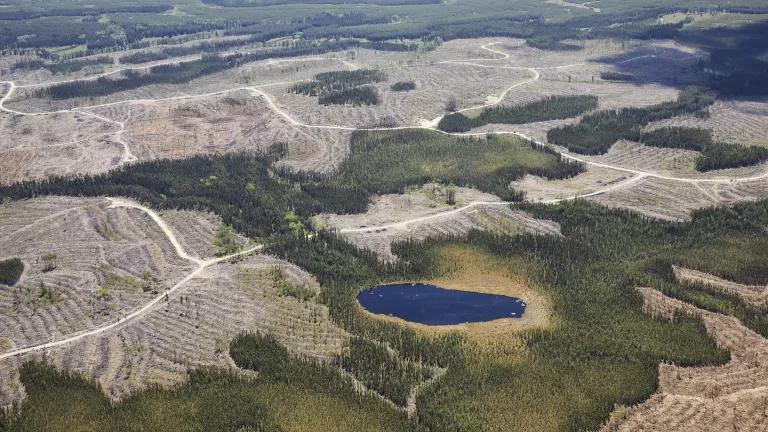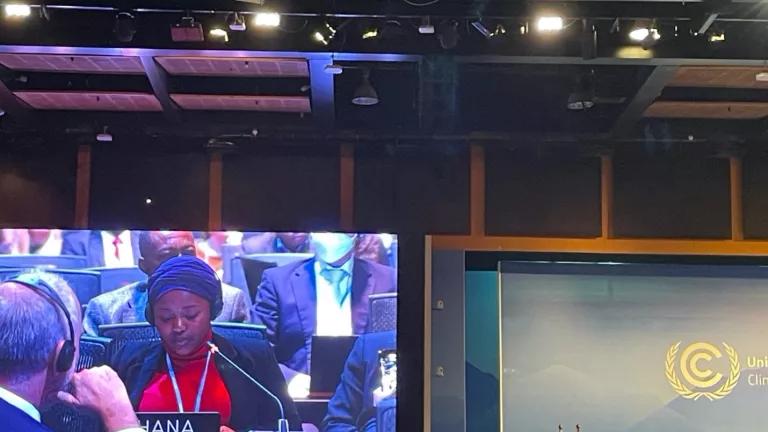
A water sample containing lead, a known neurotoxin that poses health risks, especially in children
Today, as we “Imagine a Day without Water,” we recognize that for many this is less an exercise than it is a reality. For many, a day without water is just an average day. For farmers, families, and communities of color, a day with water–water that is clean, water that is accessible, and water that is affordable–can be much harder to picture.
Water is the basis of life on earth, critical to every aspect of our lives. And yet, this finite resource has been endlessly squandered, mismanaged, and poisoned, with communities of color bearing the brunt of the repercussions. This roundup of NRDC blogs, which deal with water issues surrounding agriculture, lead contamination, school pipe flushing, utility shutoffs, and equity, examine how water issues mirror and exacerbate the most pressing issues we face as a society, such as health, systemic racism, and sustainability.
Lead Contamination: Despite Major Health Risks, the EPA Plans to Leave Millions of Lead Water Pipes in the Ground
Lead-contaminated drinking water continues to be an intractable problem in many communities throughout the U.S., especially in communities of color. There is no safe level of exposure to this poisonous, irreversible neurotoxin. Even low levels of exposure pose significant health risks, particularly to children and fetuses, including damage to the brain and nervous systems, learning disabilities, and impaired hearing. According to an NRDC analysis of EPA data, between January 2015 and March 2018, at least 5.5 million people in the United States obtained their water through water systems that exceeded the agency’s weak lead action level. Despite these devastating numbers, the EPA has proposed to extend the deadline for removing lead pipes from 14 years to 33 years, during which lead-contaminated water will continue to harm our communities, particularly low-income communities and communities of color. Much more aggressive action is required federally, as well as at the state, city, and local levels to address this issue and protect communities from the consequences of exposure to this contamination.
Read more here.
School Pipe Flushing: Reopening Schools – Drinking Water Concerns

When COVID-19 struck, ensuring clean and safe water in schools became even more problematic. As schools moved to virtual learning, many of their water systems were shut off and have now remained stagnant for months. As in-person learning has resumed in some places and is on the horizon in others, these stagnant water systems pose serious health risks to students and staff, including lead exposure, potentially cancer-causing disinfection byproducts, and microorganisms, which can cause dangerous respiratory infections like Legionnaires’ disease or gastrointestinal disease. As reopening plans are established, these risks must not be overlooked, particularly in communities of color where students already disproportionately face water shutoffs and contamination at home. The most effective way to address these concerns is by flushing a building’s water system - and that can be a 12-week process.
Read more here.

Ariana Hawk, of Flint, Michigan, warms bottled water for her son's bath
Back in March, when U.S. public health officials began advising handwashing as the first line of defense against COVID-19, they likely weren’t picturing the hundreds of thousands of people across the country who lacked running water or could not pay their utility bills due to energy insecurity—or that the pandemic would force cities and communities to shut down, only to exacerbate this hard-to-manage problem. Now, with one in five American workers filing for unemployment since mid-March, the risk of mass utility shutoffs has skyrocketed—just as residents need basics like personal hygiene, cooking, and food sanitation more than ever. These shutoffs affect communities of color most severely; in places like Detroit, this is another unjust outcome due to years of systemic racism. NRDC has been fighting locally and nationally to address this urgent issue while fixing the systems that allow it to happen.
Read more here.

Vineyard in Puente Alto, Chile
Agricultural systems and farming practices around the globe use incredible amounts of water, with places such as California using nearly 80 percent of available water toward crops. The rate at which the agriculture sector is consuming water is currently unsustainable and becoming even more so as climate change alters when and how much water is available around the globe. As a result of relying heavily and unsustainably on snow melt, groundwater aquifers, and precipitation, many communities—including farmers and rural areas—must now deal with volatile water cycles. To make this system and these communities more resilient, regenerative agriculture practices around soil health and irrigation need to be implemented and regulatory changes must be made.
Read more here.
Equitable Access to Water: Watered Down Justice: Communities of Color and the SDWA

For decades, if not centuries, there have been systems in place in this nation that have resulted in the creation and maintenance of racial and economic caste systems, from which water issues are not exempt. Due to these ingrained inequalities, access to clean water has become a source of stress, discomfort, and oppression for many. NRDC’s Watered Down Justice report provides a data-centered look at the relationship between social characteristics (e.g., race and income) and drinking water violations, revealing that communities of color, low-income communities, and communities that lack transportation and/or live under crowded housing conditions had higher rates of drinking water violations than other communities.
Read more here.
Solutions to these multifaceted water crises exist, but they require us to make significant policy changes, reevaluate our relationship with the natural world, uproot systemic racism, and reconnect with the real value of this resource. Farmers, school children, households, and communities of color should not have to face a daily reckoning with what life might be like without water, let alone live that life every day. NRDC will continue to fight for a future where imagining a day with water that is sustainably managed, safe, and accessible for all is not such a complex task.
For more info on NRDC’s water issues, visit https://www.nrdc.org/issues/water.
Many thanks to Kathryn Dunn for her assistance in writing this blog. Kathryn is a Communications Program Assistant in NRDC's Santa Monica office. She has Bachelor of Arts degrees in Government and Art from Georgetown University.



